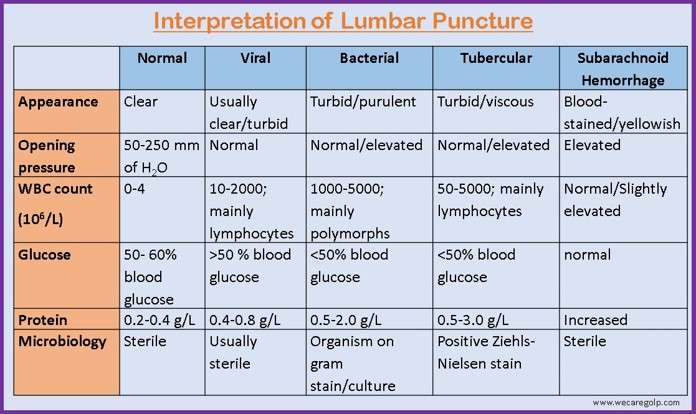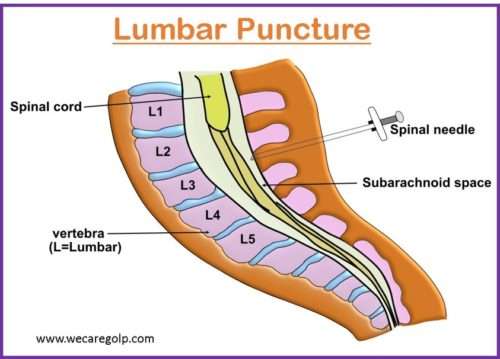Introduction
Lumbar puncture (Spinal tap) is a medical procedure in which a needle is inserted into the spinal canal, most commonly to collect cerebrospinal fluid (CSF) for diagnostic testing and occasionally for therapeutic purposes.
CSF
- CSF is a colorless, clear body fluid found in the central nervous system (brain and spinal cord) and secreted predominantly by the choroid plexus.
- It circulates in a system of communicating cavities known collectively as the CSF space.
- It coordinates and controls vital functions, including nourishment, removal of waste, and protection of the brain and spinal cord.
Indications of Lumbar Puncture
- To obtain a specimen of CSF for examination
- To exclude subarachnoid hemorrhage
- To relieve intracranial pressure
- To diagnose the following neurological disorders:
- Multiple Sclerosis
- Meningitis
- Encephalitis
- Sarcoidosis
- Guillain Barre´ syndrome
- Chronic Inflammatory Demyelinating Polyneuropathy
- Mitochondrial Disorders
- Leukencephalopathies
- Paraneoplastic Syndromes
- Autoimmune condition
- Myelitis etc.
- To administer therapeutic or diagnostic agents like
- Spinal anesthesia
- Intrathecal chemotherapy
- Intrathecal antibiotics, baclofen, etc.
- Administer contrast media in myelography or cisternography
Contraindications of Lumbar Puncture
Absolute contraindications
- Suspected infection at or near the site of needle insertion.
Relative contraindications
- Suspicion of increased intracranial pressure (ICP) that may precipitate transtentorial or cerebellar herniation following lumbar puncture due to tumor, brain abscess, or blood.
- International normalized ratio (INR) >1.5, including therapeutic anticoagulation
- Thrombocytopenia < 50,000/mm3
- Pathologically increased Activated Partial Thromboplastin Time (APTT)
- Conditions that may be aggravated by lying down during lumbar puncture
- Respiratory distress
- Cardiopulmonary insufficiency
- Anatomic abnormalities at the puncture site like
- Spinal fusion
- Laminectomy
- Congenital anomalies, etc.
Equipment required for Lumbar Puncture
- Sterile dressing/gauze pieces
- Sterile gloves
- Sterile drape/eye towel
- Antiseptic solution with swabs
- Small bowl
- Lidocaine 1% without epinephrine
- Syringe 3 mL, 5 mL, and 10 mL
- Needles, 20 and 25 gauge
- Spinal needles, 20 and 22 gauge (different sizes) with stylets
- Three-way stopcock
- Manometer
- Four plastic test tubes, numbered 1-4, with caps (Specimen vials)
Procedure
Preparation before the procedure
A few days before:
- Perform MRI or CT scan to make sure that the patient needs the lumbar puncture, and that it is safe for him.
- Advise the patient to stop taking a blood thinner like aspirin or warfarin if any.
- Suggest drinking plenty of fluids to increase the fluid amount in the body.
- Ask the patient if he is on antibiotics (current infection), allergic to any local anesthetics (lidocaine), and any chance of pregnancy (if female). If yes, the procedure may need to reschedule.
On the day:
- Tell the patient that he may not eat for three hours before the procedure. However, the Patient can drink and take medicine unless it is restricted.
- Explain the procedure to the patient and family members.
- Get informed consent.
- May the patient need to undress or change gown according to the hospital policy.
During the procedure
Positioning of the patient
Lateral decubitus position: This is generally the preferred position and should be used if CSF manometry is desired.
- Keep the patient on the side in a fetal position with the hips flexed as much as possible.
- Keep the pelvis, back, and pelvis perpendicular to the bed.
- Place a pillow under the head to align the head with the spine and between the knees for comfort if necessary.
- Provide assistance to maintain the position of the patient if needed.
Sitting position: This position s also preferred for infants and also may be helpful for obese patients.
- To flex the hips and lean forward while resting the patient’s head and shoulders on a bedside table, keep the patient at the edge of the bed with his feet on a stool or chair.
- To keep an infant in a sitting fetal position on the bed, an assistant holds the infant’s arms and legs from the front. Provide support to prevent asphyxiation due to neck flexion.
Process
- The lumbar spine is flexed to expand the intervertebral spaces.
- L3-L4 interspace is the usual insertion site but L4-L5 or L2-L3 interspace is also acceptable.
- Manometry is usually done to measure CSF pressure, but these measurements are not reliable for critically ill patients in the sitting position. Normal CSF pressure is 7 to 18 cm.
- Collect CSF samples in numerical sequence allowing about 1 to 2 mL of CSF to drip into each of the four collection tubes. Greater volumes (up to 30 to 40 mL) may be necessary for some tests, such as the detection of acid-fast bacilli, some fungi, or carcinomatous meningitis.
- Ensure to perform cell count and differential count on the 1st and 3rd tubes so that counts can be compared if red blood cells are present. (A traumatic puncture is indicated by a sharp decrease in the number of red blood cells from the first to the third tube.)
- Other tests including protein and glucose levels, oligoclonal bands, and microbiologic testing are usually done from the 2nd tube.
- Consider freezing the 4th tube in case of additional or unanticipated studies.
- Apply an adhesive dressing at the puncture site after applying pressure.
Care after the procedure
- Keep the patient on bed rest for at least an hour, and instruct to avoid strenuous activity for at least 24 hours.
- Advise drinking plenty of fluids.
- Notify the doctor if there are:
- Numbness and tingling of the legs
- Drainage of blood, leakage, or pain at the injection site
- Inability to urinate
- Headaches persisting for more than a few hours after the procedure, or while changing positions
- Persistent or worsening back pain after several days after the procedure requires prompt evaluation to exclude hematoma.
Complications of Lumbar Puncture
Common complications
- Post-lumbar puncture headache
- Bleeding into the epidural space (spinal hematoma)
- Transient nausea and/or tinnitus
Rare complications
- Lower back discomfort or pain that may radiate to the posterior legs
- Brain herniation
- Cortical blindness
- Cervical spinal cord infarction
- Transient or permanent deafness
- Iatrogenic infection
Interpretation
- Normal CSF parameters vary with age
- In the case of a traumatic tap, the predicted white cell count in the CSF is not reliable
- If the CSF is abnormal, the safest course is to treat it as if it is bacterial meningitis

Summary
- Lumbar puncture is a procedure in which a needle is inserted into the lumbar subarachnoid space to collect cerebrospinal fluid (CSF).
- The administration of intrathecal diagnostic or therapeutic agents, the measurement of CSF pressure, and laboratory testing are the primary purposes of lumbar puncture.
- Some of the complications after the procedure are spinal hematoma, lower back discomfort or pain that may radiate to the posterior legs, etc.
References
- Mandal, G.N. (2012). Textbook of Adult Nursing. Makalu Publication House, Kathmandu.
- Sharma, M. et. al. (2020). Comprehensive Textbook of Medical Surgical Nursing. Samikshya Publication, Kathmandu.
- NHS U.K. (2021, Feb 19). Lumbar puncture. https://www.nhs.uk/conditions/lumbar-puncture/
- Johns Hopkins Health System, Lumbar puncture diagnosis and treatment. Retrieved 2023, Jan 06. https://www.hopkinsmedicine.org/health/treatment-tests-and-therapies/lumbar-puncture
- Cleveland Clinic. Lumbar puncture (spinal tap) diagnosis. Retrieved 2023, Jan 06. https://my.clevelandclinic.org/health/diagnostics/12544-lumbar-puncture-spinal-tap
- Greenlee, E. J. (2022, Sep). How to do a lumbar puncture. MSD Manual Professional Version. https://www.msdmanuals.com/professional/neurologic-disorders/how-to-do-lumbar-puncture/how-to-do-lumbar-puncture
- Johnson, K. S. (2022, Dec), Lumbar puncture technique, indications, contraindications and complications in adults. Uptodate. https://www.uptodate.com/contents/lumbar-puncture-technique-indications-contraindications-and-complications-in-adults
- Biggers, A. (2022, May), Lumbar Puncture. Healthline. https://www.healthline.com/health/lumbar-puncture

